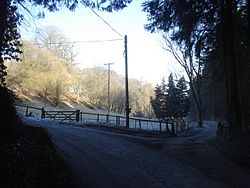Barland Castle facts for kids
Quick facts for kids Barland Castle |
|
|---|---|

The clearing and motte at Barland in 2008.
|
|
| Coordinates | 52°15′00″N 3°03′17″W / 52.2500°N 3.0546°W |
| Type | Motte-and-bailey castle |
| Site information | |
| Condition | Only the mound and ditch remain. |
| Site history | |
| Materials | Wood |
Barland Castle, also known as Bishopston Old Castle, was a special type of castle called a motte-and-bailey castle. It was built near the village of Old Radnor in Powys, Wales.
Historians believe this castle was mentioned in the Domesday Book. This was a huge survey of England and parts of Wales made in 1086. The book said the land belonged to a person named Hugh L'Asne.
In 1898, people dug up the site to learn more about it. They found pieces of pottery and other old items. These items showed the castle was used in the late 1100s to early 1200s. Over many years, the castle's name changed. It went from "Bernoldune" to "Beraldon," then "Barlondon," and finally "Barlonde." Today, only a ditch and a raised bank are left. Digs in the 1800s found proof of a wooden fence, called a palisade, that once stood there.
What Was Barland Castle Like?
Barland Castle was a motte-and-bailey castle. This means it had two main parts. The "motte" was a large earth mound, and the "bailey" was a walled courtyard. Today, only the motte mound remains.
The mound is about 23 to 26 meters (75 to 85 feet) wide. It stands about 3.2 meters (10.5 feet) tall. A ditch, about 13 meters (43 feet) wide, surrounds the north side of the mound. There's another ditch to the northwest. These ditches might have been part of older buildings on the site. The castle site is about 0.7 kilometers (0.4 miles) northeast of St Teilo's Church, Bishopston.
A Look at Barland Castle's History
The Domesday Book mentions the land near Barland Castle. It says Hugh L'Asne owned the area. He also owned other nearby places like Old Radnor and Burlingjobb. A knight named Turchil managed the land for Hugh. Back then, the area was called "Bernoldune."
Less than 100 years later, the land belonged to William de Braose, 2nd Baron Braose. By this time, it was known as "Bernoldona." Ownership then passed to Edmund Mortimer, 2nd Baron Mortimer. When he died, records listed "Beraldon" as half a knight's fee. This means it was land given in exchange for military service. Most of his lands were near Radnor. Because of these old records, historians believe these mentions refer to Barland Castle.
The first clear mention of a castle at this spot was in Peter Skydmore's will. A will is a legal document that says what happens to a person's property after they die. His will talked about a marriage agreement. It mentioned "Barlondon and Burwaire within the lordship of the castle at New Radnor."
In 1961, a writer named E.J.L. Cole suggested that "Barlondon" was just a changed version of "Beraldon." He thought the name changed between 1425 and 1450. By 1545, the castle was called "Barlonde." John a'Madog had mortgaged it to Roger Davies. Later, Davies left it to his daughter Elinor and her husband, Richard Blackbache.
Digging Up the Past: Archaeological Finds
In 1898, Lt. Colonel W.Ll. Morgan led an excavation at Barland Castle. An excavation is when archaeologists carefully dig up a site to find old objects and learn about the past. Morgan's team found holes where wooden stakes once stood. These holes were around the edge of the bank. This showed that a strong wooden fence, called a palisade, once protected the castle.
Morgan made three cuts into the bank. He found a V-shaped ditch about 2.5 meters (8 feet) deep. He also found two rows of stakes, about 1.83 meters (6 feet) apart. The front row of stakes was 6.4 to 11.4 centimeters (2.5 to 4.5 inches) wide. They were placed about 30 centimeters (12 inches) apart. The back row was not as even.
Even though they didn't find signs of a building on top of the mound, they did find interesting items. They discovered pieces of pottery from the late 1100s to early 1200s. They also found a belt buckle and parts of leather shoe soles.
In 1962, Rennell Rodd, 1st Baron Rennell looked into Cole's idea about the name "Bernoldune" changing to "Barland." He visited the Barland site. The size of the site matched what was described in the Domesday Book. This made him agree with Cole that the two places were the same. However, he thought any later manor house would have been at Burfa farm nearby, not on the mound itself.
Today, the Barland Castle site is on private land.

